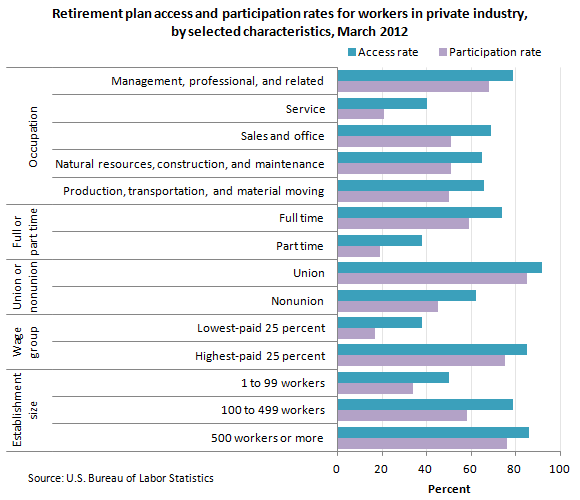September 21, 2012 (The Editor’s Desk is updated each business day.)
Who has retirement benefits in private industry in 2012?
Nearly two-thirds of private industry workers in March 2012 had access to some form of retirement plan, typically either a defined-benefit plan, such as a pension, or defined-contribution plan, such as a 401(k). Forty-eight percent of workers chose to participate in a retirement plan.

[Chart data]
Access to retirement plans varied significantly by major occupational group, full- or part-time status, union-membership status, and wage category. Management, professional, and related occupations had nearly twice the access rate and more than three times the participation rate of service occupations. (Some examples of service occupations are healthcare support, protective service, food preparation, maintenance, and personal care workers.) Similarly, full-time workers had nearly twice the access rate and three times the participation rate of part-time workers. Union workers had very high access (92 percent) and participation (85 percent) rates for retirement plans.
High-wage workers (those in the top 25 percent of all wage earners, with earnings at or above $24.81 per hour) had significantly higher rates of access to and participation in retirement plans than did low-wage workers (those in the lowest 25 percent of all wage earners, with earnings at or below $10.69 per hour).
Workers in large establishments (500 workers or more) had a retirement participation rate more than twice that of workers in small establishments (fewer than 100 workers).
These data are from the National Compensation Survey - Benefits program. To learn more, see "Who has benefits in private industry in 2012?" (HTML) (PDF), Beyond the Numbers volume 1, number 13, September 2012. An employee had access to a benefit plan if the employee is in an occupation in which his or her employer offered the plan. The participation rate is the percentage of employees who actually enroll in a retirement plan.
Related TED articles
Benefits |
Occupations |
Retirement |
Size of establishment
Of interest
Spotlight on Statistics: National Hispanic Heritage Month
In this Spotlight, we take a look at the Hispanic labor force—including labor force participation, employment and unemployment, educational attainment, geographic location, country of birth, earnings, consumer expenditures, time use, workplace injuries, and employment projections.
Read more »
